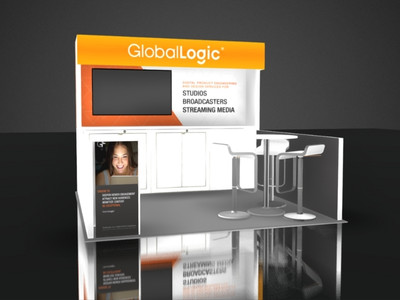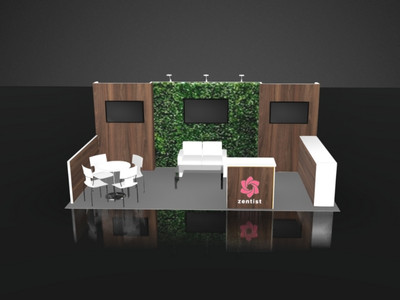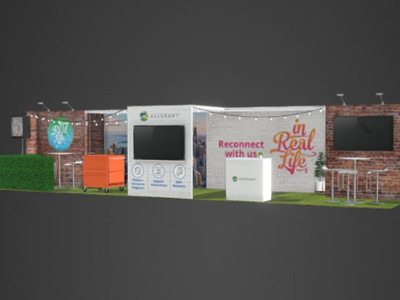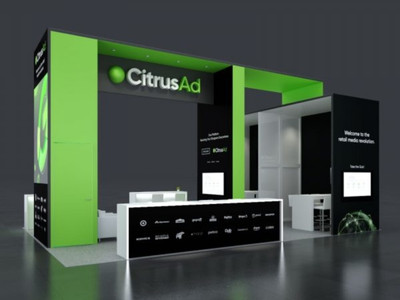7 Ways to Avoid the Dreaded FORCED FREIGHT!
It’s a call that can stop you dead in your tracks after a trade show.
“I’m sorry, but we had to force freight your booth.”
At first, you may be asking yourself, “What does that have to do with me? What does that even mean?” Forced Freight is any exhibitor’s worst nightmare and can be extremely expensive to deal with. And if you own your own exhibit booth, it’s something you have to keep a very close eye on so that it doesn’t happen to you!
What is Forced Freight?
When a trade show makes a contract with a convention center, they agree upon specific times that the space can be in use. The show organizers will assign a GSC, general service contractor, to make sure the space is ready for loading exhibitors in and make sure all exhibitors get out. Leaving your booth on the floor for over the contracted time will result in the GSC being forced to remove your materials.
Depending on the contract the GSC may remove your booth and store it in their warehouse or send it somewhere via the official freight contractor from the show site. This is where it can get tricky and expensive. This is forced freight; the action of the trade show staff ‘forcing’ your booth off the show floor after the contracted time there has ended.
How Can Forced Freight Happen?
Your trade show freight services didn’t show up
Either they didn’t show up at all, or they didn’t show up in the contracted time. If they don’t show up before the previously agreed upon date, the GSC will have your booth forcibly removed.
Late or incomplete material-handling form
Show paperwork will include a sheet on how you plan to load your booth in and out. Installation and dismantle forms can be separate depending on the show and sometimes you may not get them until you are physically at the convention.
Either way, these forms are important to communicate with your general contractor on how you are dealing with your loadout. If you do not fill them out on time or without completed information, they have a right to do with your booth whatever they’d like to get rid of it.
Freight turned away
Some show sites only allow common carriers to come and unload or ship from their exhibit hall docks. This can be done to contracts or union requirements. Communicating with your GSC to make sure your preferred freight will work is important. Another cause of forced freight is when the trade show freight carriers you hired get turned away; either by mistake or because the GSC does not allow them.
Carrier getting lost due to lack of signs
While loading out of a show site, sometimes booth numbers and signs can be taken down. This can confuse a carrier. Communicate well with your shipping company to find your space, which can also lead to forced freight.
Inexperienced staff or freight team
Sometimes the staff at a convention may not know where your booth is, or how to communicate that information with your carrier. Similarly, if you are working with an inexperienced freight service, they may not know where to go. Be aware of the people who are running the show and of who you hire to ship. It can save you money in the long run.
What Can a Forced Freight Do?
The main downsides to forced freight are the monetary costs and inconveniences. If you are shipping using the show’s freight contractor, you will have to pay their inflated fees. If your freight is sent to a warehouse, there will be multiple fees connected to it AND you’ll have to figure out how to get it back into your possession.
Fees
Forced freight has a ton of moving parts. You acquire fees every time someone outside your own company or contracts has to touch your booth —the price can really go up! GSC prices are never very cost effective and getting your freight from a GSC can be very inconvenient. Here are some common force freight charges:
- Off-Target Fees – Some conventions have a certain check-in time for certain booths to move their materials. If someone has to do it for you, you can get charged for not moving at the right time.
- Overtime Fees – If the GSC has to move your exhibit and it happens to fall on a weekend or holiday, you may have to not only pay their workers an inflated price but also over time for that inflated price
- Shipping Charges – Once a GSC has loaded up your booth to move, they will more than likely charge you a shipping cost to move it to whatever location it needs to go
- Waiting Time – If the freight in charge of shipping has to wait on workers or to drop off your materials, they may charge you a weighting time fee.
- Aborted/Attempted Pick Up – If your original carrier tried to get to the convention, but was turned away by GSC because they were not a contracted freight, they may also charge you a fee
- Material Handling Fees – You’ll be charged for everyone involved with moving your stuff, either in the trade show hall or at the warehouse they are sent to
- Storage Fees – If your freight is sent to a GSC’s warehouse to store while you and the GSC are trying to figure out what to do next, you’ll have to for storing the materials in the meantime.
How Can I Prevent Forced Freight?
Most people in charge of planning for a large show don’t have time to sit and watch every working cog. However, now that you’ve read this article, you know the events and steps of the show you have to plan for.
From material handling agreement paperwork to communications with your GSC, the exhibit manager, and your personal freight. Calling and asking a lot of questions should be your first step. Once you’ve figured out your shipping and times, you can start to make a checklist!
Your Forced Freight Prevention Checklist
- 1.) Check up on your carrier. Make sure they know where they have to go and what times they have to be there in order to be ready in the allotted time your contract denotes.
- 2.) Confirm all pickups times with your trade show shipping services. Also, confirm when your paperwork is due
- 3.) Appoint someone in charge of your booth tear down if you are not there. Be sure they are completely aware of times they need to have the forms in and when your carrier will be there to pick up, ect.
- 4.) Prepare your materials for pick up. Properly pack and store items with a clear indication as to what booth number they are at. This will help you carrier.
- 5.) Store your materials in obvious storing containers and label them clearly for your carrier. You wouldn’t want your carrier to miss anything, leave it behind or accidentally drop it off a wrapped crate
- 6.) Clearly and accurately filled out your paperwork for the GSC. (Often called UMHA) Add a phone number that can be contacted 24 hours a day in case there are any questions or issues with your form. Be sure to include the exact number of items for pick up (crates, wrapped pallets, ect) Be sure to get a signed copy of it when you turn it in. You’ll want to know the time, date and person who got the form in case there are any issues.
- 7.) While packing up at the end of your show, double check your inventory of items that need to be picked up. Tell your carrier your inventory count to help them double check they don’t leave anything behind.
Avoid Forced Freight When Exhibiting in Las Vegas
You have a lot to remember when you go to a show, don’t stress out over forced freight! When you rent a booth from Exhibit Pros in Las Vegas, you’ll never have to worry about installation or dismantle semantics. This is one of the many reasons why you should rent a trade show booth. Contact our staff at Exhibit Pros today and we’ll save you time and money at your next show!






